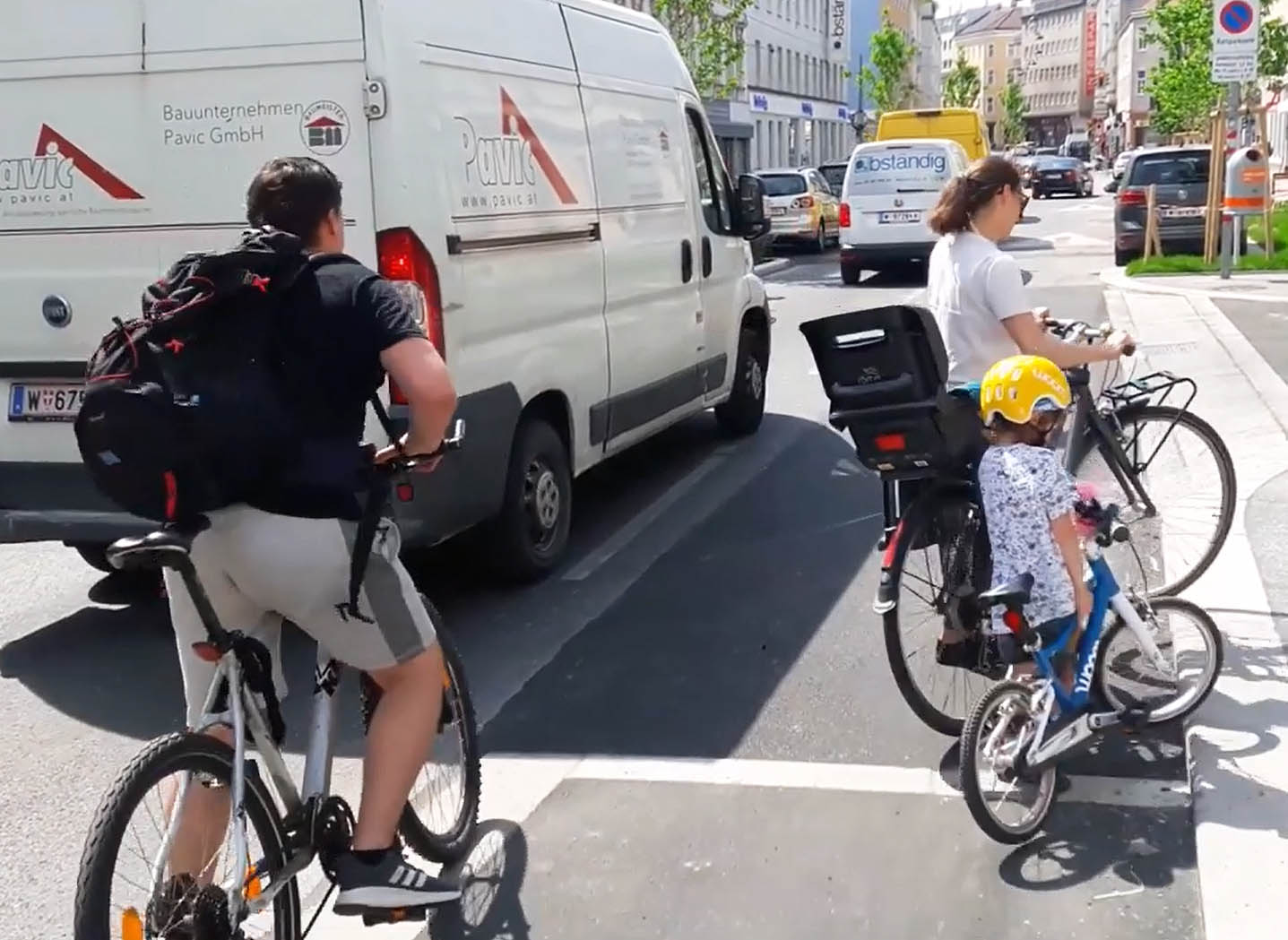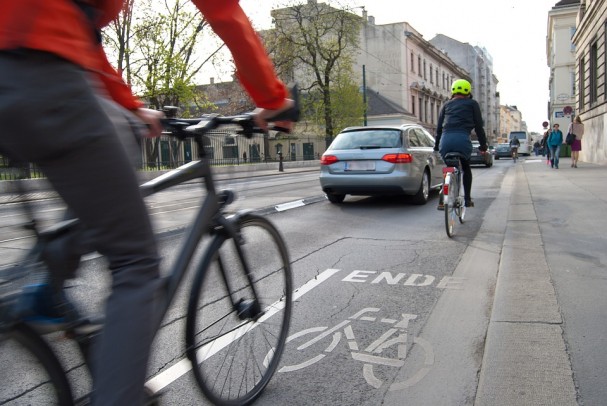City comparison: How satisfied are Austria’s cyclists?

How safe do Austria’s cyclists feel in traffic? How do they rate the quality of bike paths? These are the questions that Radlobby Austria, member of Cycle Competence, asked in its bicycle climate test, the results of which have just been published. Salzburg and Graz received the best marks, but are still not entirely satisfactory. Vienna and Linz are at the bottom of the list behind Innsbruck and Dornbirn.
More than 3,000 cyclists from 415 communities rated the situation in their areas on a scale from a top score of 1 to a bottom score of 6. They are generally dissatisfied with the conditions. Radkompetenz member the City of Salzburg tops the list with 3.47 points, but safety, comfort and the importance of cycling were also rated negatively there. Linz is at the bottom of the list of the six cities compared with 4.33 points.
Strengths and weaknesses of the cities
In the city ranking, Graz ranks second, Dornbirn and Innsbruck share third place, and Vienna ranks fourth. The cycling climate in Linz seems particularly bleak. None of the cities achieved a clearly positive overall result. The survey shows where there is room for improvement and what cyclists are already fairly satisfied with.
Salzburg is best with an average test score
In Salzburg, cyclists are particularly satisfied with the accessibility of the city center – with a very good score of 1.79! – and the number of one-way streets that are open to cyclists in the opposite direction. However, there is a lack of public rental bikes and good diversions when there are construction sites. Overall, Salzburg is just above the average of 3.5 and is still Austria’s best cycling city.
 City center accessibility 1.79, Accessibility of nearby towns 2.26, Open one-way streets 2.31
City center accessibility 1.79, Accessibility of nearby towns 2.26, Open one-way streets 2.31
Public hire bikes 4.84, Illegal parking regulation 4.73, Navigation of building sites 4.62
Graz ranks second
Cyclists in the Styrian capital are particularly satisfied with the number of one-way streets that are open to cyclists and the accessibility of the city center, while bike transport on public transport and guidance at construction sites were clearly rated negatively. Graz residents also criticize the width of the cycle paths. The implementation of the ambitious Graz Master Plan could provide a solution!

Open one-way streets 2.18, City center accessibility 1.79, Realistic everyday means of transport 2.47
Bike transport on public transport 5.44, Navigation of building sites 4.84, Width of bike lanes 4.59
Bicycle-friendly Dornbirn ranks third
In Dornbirn, the respondents are also satisfied with the number of one-way streets that are bi-directionally open to cyclists and the accessibility of the city center and surrounding towns. Ratings of traffic lights, guidance at construction sites and cycling in mixed traffic have performed particularly poorly however.
 Open one-way streets 2.29, City center accessibility 2.44, Accessibility of nearby towns 2.69
Open one-way streets 2.29, City center accessibility 2.44, Accessibility of nearby towns 2.69
Traffic lights 5.0, Navigation of building sites 4.75, Riding in mixed traffic (with motor vehicles) 4.56
Bike-sharing as a bonus in Innsbruck
Innsbruck shares third place with Dornbirn. Cyclists in the Tyrolean capital rate the offer of public rental bikes – 340 city bikes at 40 stations – and the accessibility of the city center and the next largest town positively, while cycling in mixed traffic is rated as insufficient. According to their assessment, the city neglects the checking of illegal parking and the signage at construction sites.
 Public hire bikes 2.26, City center accessibility 2.5, Accessibility of nearby towns 2.63
Public hire bikes 2.26, City center accessibility 2.5, Accessibility of nearby towns 2.63
Riding in mixed traffic (with motor vehicles) 4.73, Illegal parking regulation 4.66, Navigation of building sites 4.65
Lack of subjective safety in Vienna
Cyclists in Vienna also rate the situation of public rental bikes favorably – the new WienMobil system has 3,000 bicycles at 240 stations. The accessibility of the city center also scored highly. According to the survey results, those who ride their bikes in Vienna do so on cycle paths that they see as too narrow, receiving the worst score of 5.17 for this criterion. Whether the “Cyclepath Offensive 2023” with 20 kilometers of new cycling infrastructure can counter this opinion remains to be seen. The feeling of safety on cycle paths and cycle lanes was also rated negatively, as it is at traffic lights.

Public hire bikes 2.66, City center accessibility 2.94, Realistic everyday means of transport 3.17
Width of bike lanes 5.17, Traffic lights 5.10, Safety of bike paths and bike lanes 5.11
“Steel-City” Linz occupies the last place
Of all the cities that were evaluated in the bicycle climate test, Linz performed the worst. According to the residents of Linz, there is a particular need for improvement in terms of taking bicycles on public transport, the width of the bike paths, and also in guiding cyclists around construction sites. However, the bike rental service offered by Citybike Linz received a positive review, with its 42 stations.
 Public hire bikes 2.96, Open one-way streets 3.24, City center accessibility 3.4
Public hire bikes 2.96, Open one-way streets 3.24, City center accessibility 3.4
Bike transport on public transport 5.65, Width of bike lanes 5.26, Navigation of building sites 5.21
Cycling stress creates a poor traffic climate
Of the 3,058 participants, nearly half considered themselves to be experienced cyclists, while almost 40% considered themselves to be experts. Sixty percent of the participants cycle daily, and almost 25% cycle several times a week. They want to feel safe in traffic, with safety being the top priority, which has a lot to do with infrastructure and maintenance, such as winter service on cycle paths, conflict-free coexistence between cyclists and pedestrians, obstacle-free cycle paths, and cycle paths that are in good condition and are wide enough to be used well.
In particular, cycling in mixed traffic and safety on cycle paths and cycle lanes were rated poorly in the test. Perceived conflicts with car drivers often occur in cities, with a survey rating of 4.75. Cyclists encounter conflicts with pedestrians less frequently, but the score of 3.74 is still high.
Download results (PDF, german) at radlobby.at
Quelle: https://www.radlobby.at/fahrradklimatest
Cycling Competence Members in this article:
More articles with this member:
[crp]
Share this article:
City comparison: How satisfied are Austria’s cyclists?
Share this article:

How safe do Austria’s cyclists feel in traffic? How do they rate the quality of bike paths? These are the questions that Radlobby Austria, member of Cycle Competence, asked in its bicycle climate test, the results of which have just been published. Salzburg and Graz received the best marks, but are still not entirely satisfactory. Vienna and Linz are at the bottom of the list behind Innsbruck and Dornbirn.
More than 3,000 cyclists from 415 communities rated the situation in their areas on a scale from a top score of 1 to a bottom score of 6. They are generally dissatisfied with the conditions. Radkompetenz member the City of Salzburg tops the list with 3.47 points, but safety, comfort and the importance of cycling were also rated negatively there. Linz is at the bottom of the list of the six cities compared with 4.33 points.
Strengths and weaknesses of the cities
In the city ranking, Graz ranks second, Dornbirn and Innsbruck share third place, and Vienna ranks fourth. The cycling climate in Linz seems particularly bleak. None of the cities achieved a clearly positive overall result. The survey shows where there is room for improvement and what cyclists are already fairly satisfied with.
Salzburg is best with an average test score
In Salzburg, cyclists are particularly satisfied with the accessibility of the city center – with a very good score of 1.79! – and the number of one-way streets that are open to cyclists in the opposite direction. However, there is a lack of public rental bikes and good diversions when there are construction sites. Overall, Salzburg is just above the average of 3.5 and is still Austria’s best cycling city.
 City center accessibility 1.79, Accessibility of nearby towns 2.26, Open one-way streets 2.31
City center accessibility 1.79, Accessibility of nearby towns 2.26, Open one-way streets 2.31
Public hire bikes 4.84, Illegal parking regulation 4.73, Navigation of building sites 4.62
Graz ranks second
Cyclists in the Styrian capital are particularly satisfied with the number of one-way streets that are open to cyclists and the accessibility of the city center, while bike transport on public transport and guidance at construction sites were clearly rated negatively. Graz residents also criticize the width of the cycle paths. The implementation of the ambitious Graz Master Plan could provide a solution!

Open one-way streets 2.18, City center accessibility 1.79, Realistic everyday means of transport 2.47
Bike transport on public transport 5.44, Navigation of building sites 4.84, Width of bike lanes 4.59
Bicycle-friendly Dornbirn ranks third
In Dornbirn, the respondents are also satisfied with the number of one-way streets that are bi-directionally open to cyclists and the accessibility of the city center and surrounding towns. Ratings of traffic lights, guidance at construction sites and cycling in mixed traffic have performed particularly poorly however.
 Open one-way streets 2.29, City center accessibility 2.44, Accessibility of nearby towns 2.69
Open one-way streets 2.29, City center accessibility 2.44, Accessibility of nearby towns 2.69
Traffic lights 5.0, Navigation of building sites 4.75, Riding in mixed traffic (with motor vehicles) 4.56
Bike-sharing as a bonus in Innsbruck
Innsbruck shares third place with Dornbirn. Cyclists in the Tyrolean capital rate the offer of public rental bikes – 340 city bikes at 40 stations – and the accessibility of the city center and the next largest town positively, while cycling in mixed traffic is rated as insufficient. According to their assessment, the city neglects the checking of illegal parking and the signage at construction sites.
 Public hire bikes 2.26, City center accessibility 2.5, Accessibility of nearby towns 2.63
Public hire bikes 2.26, City center accessibility 2.5, Accessibility of nearby towns 2.63
Riding in mixed traffic (with motor vehicles) 4.73, Illegal parking regulation 4.66, Navigation of building sites 4.65
Lack of subjective safety in Vienna
Cyclists in Vienna also rate the situation of public rental bikes favorably – the new WienMobil system has 3,000 bicycles at 240 stations. The accessibility of the city center also scored highly. According to the survey results, those who ride their bikes in Vienna do so on cycle paths that they see as too narrow, receiving the worst score of 5.17 for this criterion. Whether the “Cyclepath Offensive 2023” with 20 kilometers of new cycling infrastructure can counter this opinion remains to be seen. The feeling of safety on cycle paths and cycle lanes was also rated negatively, as it is at traffic lights.

Public hire bikes 2.66, City center accessibility 2.94, Realistic everyday means of transport 3.17
Width of bike lanes 5.17, Traffic lights 5.10, Safety of bike paths and bike lanes 5.11
“Steel-City” Linz occupies the last place
Of all the cities that were evaluated in the bicycle climate test, Linz performed the worst. According to the residents of Linz, there is a particular need for improvement in terms of taking bicycles on public transport, the width of the bike paths, and also in guiding cyclists around construction sites. However, the bike rental service offered by Citybike Linz received a positive review, with its 42 stations.
 Public hire bikes 2.96, Open one-way streets 3.24, City center accessibility 3.4
Public hire bikes 2.96, Open one-way streets 3.24, City center accessibility 3.4
Bike transport on public transport 5.65, Width of bike lanes 5.26, Navigation of building sites 5.21
Cycling stress creates a poor traffic climate
Of the 3,058 participants, nearly half considered themselves to be experienced cyclists, while almost 40% considered themselves to be experts. Sixty percent of the participants cycle daily, and almost 25% cycle several times a week. They want to feel safe in traffic, with safety being the top priority, which has a lot to do with infrastructure and maintenance, such as winter service on cycle paths, conflict-free coexistence between cyclists and pedestrians, obstacle-free cycle paths, and cycle paths that are in good condition and are wide enough to be used well.
In particular, cycling in mixed traffic and safety on cycle paths and cycle lanes were rated poorly in the test. Perceived conflicts with car drivers often occur in cities, with a survey rating of 4.75. Cyclists encounter conflicts with pedestrians less frequently, but the score of 3.74 is still high.
Download results (PDF, german) at radlobby.at
Quelle: https://www.radlobby.at/fahrradklimatest
Cycling Competence Members in this article:
More articles with this member:
[crp]

